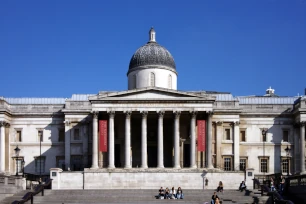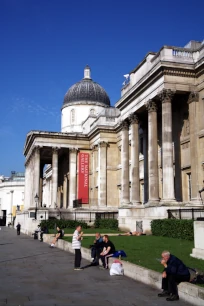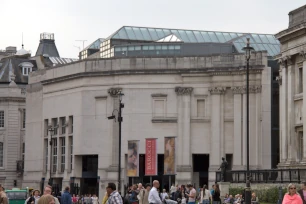The National Gallery is one of London’s most important museums. It has an impressive collection of paintings covering the period between 1260 and 1900, with works from virtually all renowned artists of the era.
History

At the beginning of the nineteenth century, King George IV realized that many European cities had opened impressive art museums to the public, such as the Louvre in Paris, the Vatican Museums in Rome and the Uffizi in Florence.
George IV did not want Britain to be left behind, so in 1824 he pushed a reluctant government into purchasing the house of the just deceased John Julius Angerstein, a rich Russian banker and art collector. The purchase included a valuable collection of thirty-four paintings with works from renowned artists such as Rembrandt and Rubens. The works were initially displayed in the banker’s residence at Pall Mall.
Over the years, the collection expanded to one of the most prestigious in Europe. Over 2,300 paintings are now on display in the monumental building at Trafalgar Square.



The Building
The neoclassical building that now houses the museum was completed in 1838 after a much-criticized design by English architect William Wilkins. It was built at the then still to be developed Trafalgar Square, which had just been cleared.
Plans to replace the building were never realized, and in 1876 the museum was expanded with a new east wing. In the mid-1980s plans for a new expansion were launched, but the modern design faced so much opposition – most notably from the Prince of Wales – that it was shelved and replaced with a more conventional building, known as the Sainsbury wing.
The Collection
The National Gallery’s collection includes European paintings from the thirteenth to the nineteenth centuries. The works are arranged in a more or less chronological order.


The museum’s main entrance is at the Sainsbury wing, to the left of the main building, where you’ll find the oldest paintings such as works by Giotto and Jan van Eyck. Late Renaissance works from Titian, Michelangelo and others can also be found in the west wing. Seventeenth-century paintings from Italy, Flanders, Spain and the Netherlands are displayed in the north wing and features works from masters such as Rubens, van Dyck, Rembrandt and Caravaggio. Paintings from the eighteenth and nineteenth centuries are on display in the east wing. Here you’ll find impressionist and post-impressionist works from artists like van Gogh, Seurat and Renoir.
More Galleries
London boasts many more interesting galleries. Modern art can be found in Tate Modern, and Tate Britain features paintings from British Artists.
Adjacent to the National Gallery is the National Portrait Gallery, which presents paintings portraying prominent English personalities such as Sir Christopher Wren and Churchill. It is the most important museum of its kind.
The Courtauld Gallery, founded by the will of the industrialist Samuel Courtauld and located in Somerset House, is another excellent gallery with paintings from the Renaissance to the twentieth century. Its collection of impressionist and post-impressionist paintings is particularly strong.
Another noteworthy gallery in London is the Dulwich Picture Gallery, with works by masters such as Van Dyck, Rubens, Rembrandt and Gainsborough.
The Queen’s Gallery, which has its home at Buckingham Palace, exhibits paintings from the royal collection.
- Next: Kew Gardens
- More Sights & Attractions in London

